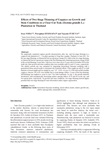Effects of Two-Stage Thinning of Coppices on Growth and Stem Conditions in a Clear-Cut Teak (Tectona grandis L.) Plantation in Thailand
Japan Agricultural Research Quarterly
| ISSN | 00213551 |
|---|---|
| NII recode ID (NCID) | AA0068709X |

Full text
jarq59-2_163-174.pdf3.4 MB
We empirically examined coppice growth characteristics after one- and two-stage thinning in a coppiced teak plantation (2 × 4 m plant spacing) in Nong Bua Lamphu, Thailand, in June 2011. For the one-stage thinning, we thinned all but one sprout per stump (P1), while in the two-stage thinning, we thinned all but two sprouts per stump in the first thinning and a dominant sprout per stump (P2ds) in the second thinning 4 years later. Teak trees were clear-cut at 15 years old in December 2010 at the study site; their growth and stem condition data were available until 8.6 and 4.5 years, respectively. The relative growth rate was estimated by integrating hierarchical Bayesian modeling with a generalized linear mixed model to determine the treatment effects. P2ds caught up with P1 in both diameter at breast height and tree height by year 7 (P > 0.05). At year 4.5, P2ds showed 86% healthy coppices, whereas 74% of P1 were healthy due to wind damage within ~2 years of the first thinning. Self-thinning was implied to occur in year 5 for both treatments. In year 4, the growth diameter decelerated, with asymptotically decreasing relative spacing indices of 23 and 20 on the one- and two-sprout plots, respectively. On growth and stem conditions, two-stage thinning showed higher potential than one-stage thinning for teak reforestation under coppice regeneration.
| Date of issued | |
|---|---|
| Creator | Iwao NODA Woraphun HIMMAPAN Naoyuki FURUYA |
| Subject | hierarchical Bayesian modeling mixed effects model relative growth rate relative spacing index sustainable forestry |
| Publisher | Japan International Research Center for Agricultural Sciences |
| Received Date | 2024-04-22 |
| Accepted Date | 2024-08-26 |
| Available Online | |
| Volume | 59 |
| Issue | 2 |
| spage | 163 |
| epage | 174 |
| DOI | 10.6090/jarq.24J02 |
| Language | eng |
